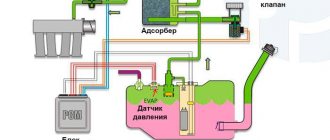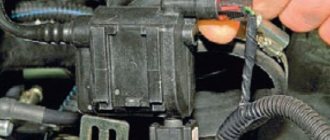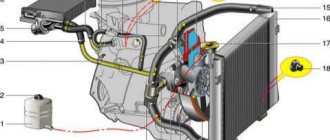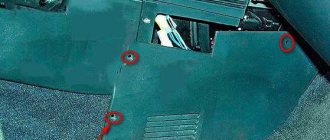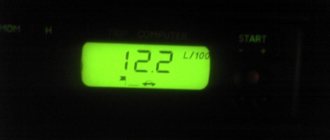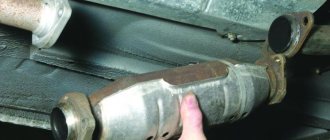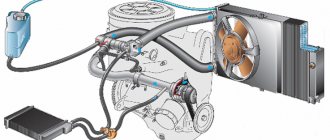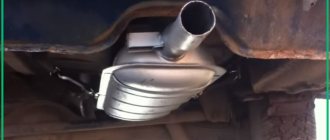How to get rid of the smell of gasoline
The smell of gasoline in the cabin is always very alarming, because it means that there is a gasoline leak somewhere, and this is no longer safe.
In this article we will try to find out whether there is one reason for the smell of gasoline in the cabin or there may be several, and also how to eliminate it. To understand where the smell of gasoline may be coming from in your car, you should study the car's fuel supply diagram. Let's look at the example of a car of the tenth family:
1 — nozzles; 2 — fitting plug for monitoring fuel pressure; 3 — injector ramp; 4 — bracket for fastening fuel pipes; 5 — fuel pressure regulator; 6 — adsorber with solenoid valve; 7 — hose for suction of gasoline vapors from the adsorber; 8 — throttle assembly; 9 - two-way valve; 10 - gravity valve; 11 - safety valve; 12 - separator; 13 — separator hose; 14 — fuel tank plug; 15 - filling pipe; 16 — filling pipe hose; 17 — fuel filter; 18 — fuel tank; 19 — electric fuel pump; 20 — fuel drain line; 21 - fuel supply line.
Osipov Mikhail, VAZ 2112, Toyota Camry, driving experience 11 years.
Hi all! My name is Mikhail, now I’ll tell you a story about how I managed to exchange my two-wheeler for a 2010 Camry. It all started with the fact that I began to be wildly irritated by the breakdowns of the two-wheeler, it seemed like nothing serious was broken, but damn it, there were so many little things that really started to irritate me. This is where the idea arose that it was time to change the car to a foreign car. The choice fell on the melting Camry of the tenth years.
Yes, I had matured morally, but financially I just couldn’t handle it. I’ll say right away that I am against loans and taking a car, especially not a new one, on credit is unreasonable. My salary is 24k a month, so collecting 600-700 thousand is almost impossible for me. I started looking for different ways to make money on the Internet. You can’t imagine how many scams there are, what I haven’t tried: sports betting, network marketing, and even the Vulcan casino, where I successfully lost about 10 thousand ((The only direction in which it seemed to me that I could make money was currency trading on the stock exchange, they call it Forex. But when I started delving into it, I realized that it was very difficult for me. I continued to dig further and came across binary options. The essence is the same as in Forex, but it’s much easier to understand. I started reading forums, studying trading strategies. I tried it on a demo account, then opened a real account. To be honest, I didn’t manage to start earning money right away, until I understood all the mechanics of options, I lost about 3,000 rubles, but as it turned out, it was a precious experience. Now I earn 5-7 thousand rubles a day. I managed to get the car buy after half a year, but in my opinion this is a good result, and it’s not about the car, my life has changed, I naturally quit my job, I have more free time for myself and my family. You’ll laugh, but I work directly on the phone)) If If you want to change your life like me, then here’s what I advise you to do right now: 1. Register 2. Practice on a Demo account (it’s free). 3. As soon as you get something on the Demo account, top up your REAL ACCOUNT and go to REAL MONEY!
I also advise you to download the application to your phone, it’s much more convenient to work from your phone.
Reason #1: Filler pipe (2108-1101080). This is the hose that connects the filler neck and the gas tank. It cracks due to age, the problem is solved by replacing it. Reasons: gasoline leaks when the tank is full and when refueling.
Reason #2: Separator vent hose (2110-1164089) or separator hose 2110-1101079.
Gasoline vapor recovery system (Separator), on VAZ 2110, 2111, 2112 it is mounted under the left rear fender. We check/blow out the hoses and, if necessary, change/clean them with a spoke and a compressor. By the way, these are not the only pipes that can leak; carefully check the entire fuel line for leaks.
Structurally, the separator ventilation hose is located in a hole in the body side member, which is not entirely successful. If the car does not have a gasoline vapor recovery system installed, then vapors can easily penetrate into the interior through the internal cavities. Such a mistake by engineers can be eliminated through modification. You will need a fuel tank check valve VAZ 2105, 2108-099, 2110 (code 21050-1164060) and a safety valve cap VAZ 21082 (code 21082-1101194).
- We remove the separator ventilation hose from the side member (in the arch of the removed wheel).
- We heat the end of the hose in hot water or crush it with pliers.
- We put the purchased valve with a cap on this hose.
- We take our device behind the separator and secure it with clamps.
Reason No. 3: Attaching the fuel pump. The fuel pump is secured using a pressure ring, and an O-ring is installed to prevent gasoline vapors from entering the passenger compartment.
We check the condition of this gasket, the terminal block seal on the fuel pump and whether the clamping ring nuts are tightened sufficiently (removal instructions).
It is not uncommon for fuel tank studs to break and have to be rebuilt. A temporary solution in this case is to seal the gas tank flap with tape. Reason No. 4 The gas tank is broken. In this case, the fuel tank is repaired.
Our readers recommend!
In order to get rid of constant fines from cameras, many of our readers successfully use Special Nano Film for license plates. A legal and 100% reliable way to protect yourself from fines. Having familiarized ourselves and carefully studied this method, we decided to offer it to you.
Our readers recommend!
In order to get rid of constant fines from cameras, many of our readers successfully use Special Nano Film for license plates. A legal and 100% reliable way to protect yourself from fines. Having familiarized ourselves and carefully studied this method, we decided to offer it to you.
Photo source:
Keywords:
- gas tank
- bad smells
- car fuel system
Tank ventilation. It smells like gasoline. The reason has been found - logbook of Lada 2108 German 1991 on DRIVE2
About a month ago, when it was sunny outside and over +24 degrees, the smell of gasoline appeared several times while driving. Having crawled around the entire engine compartment, I still couldn’t find any leaks. Then I decided to check if the tank cap was closed (it’s locked with a key). — It turned out to be open, and when I unscrewed it a little, it made a good fuss. — the smell of gasoline stopped. Then, when after a while the aromas began again, I stopped, again relieved the pressure in the tank through the cap, and the smell went away.
After reading on the Internet about tank ventilation, as far as I understand, I should have a two-way valve
but I do not have it. In its place is a rubber plug, under which there is nothing.
As far as I understand, this valve is not present on injection machines, those with an adsorber. But I don’t have it either.
Having removed the bumper from one side, the following picture was revealed to the front door:
1 - this tube is connected to the top of the tank (as I understand it is just ventilation) 2 - it is connected to a gravitational (whatever it is) sensor, and then goes somewhere forward behind the tank. - It turns out that my system is closed. There is no ventilation. Now I ride with the lid not tightly screwed on. When it is opened, nothing happens. But how can I properly do this ventilation? After all, it’s not an option to ride like this all the time. I’m thinking of doing it like on a classic, putting out a ventilation tube next to the neck, and I’m thinking of throwing out the separator altogether... But what kind of tube should I put out? Where to connect the rest?—-
UPD:
Found the diagrams:
injector
Everything seems simple, BUT: 1. I have a gravity valve (No. 10 on the injection diagram). It is not on the carburetor, and judging by its appearance, it has been there since the factory.2. The hose (No. 20) which in the carburetor circuit goes from the separator to the valve (No. 21) is connected to a metal hose and goes behind the tank (there was no way to track where exactly it goes) I had and still have a carburetor car. There is clearly no collective farm or alterations. Everything is in the same condition and it’s clear that it was like this from the factory. If I start remaking the system according to the carburetor diagram, then where should I put the second hose? Which one is from the gravity sensor?—UPD 2:
I climbed under the car again:
Full size
1 - the hose connects to the filler neck 2 - goes to the separator 3 - goes from the separator through the gravity sensor
Full size
A flexible hose after the separator and gravity sensor is connected to a metal
Full size
He goes around the tank and goes somewhere forward
—UPD 3:
In the evening I tracked down where this highway goes
It comes out in the engine compartment, where it is plugged with a bolt... Now it’s clear why it stank of gasoline in hot weather: The gasoline expanded, the vapors created pressure, which came out under the hood through this plugged tube. Well, you can breathe a sigh of relief and bring this hose out under rear bumper. —Everything is fine, but from all this I have a question: is it still like it was from the factory? Where did this pipe connect under the hood? The car is an export car - from Germany, it was and is carburetor. Initially there was an automatic choke, but then it was converted to a regular one.
The question is open...
ON-BOARD DIAGNOSTICS FOR FAULT DETECTION
A malfunction of the fuel system leads to a deviation in pressure in the fuel rail. As a result, the amount of fuel supplied to the cylinders differs from the calculated one, and the air-fuel mixture becomes depleted or enriched. In engine management systems with an oxygen sensor, the controller monitors the current composition of the air-fuel mixture.
If the air-fuel mixture deviates significantly from the desired value, the controller perceives this condition as a malfunction, and one of two fault codes is recorded in the controller’s memory:
- P0171 - fuel system too lean;
- P0172 - fuel system too rich.
Increased or decreased pressure in the fuel rail is just one of the reasons why codes P0171, P0172 can be recorded in the controller’s memory. The cause of a significant depletion or enrichment of the air-fuel mixture may be faulty mass air flow sensors, oxygen sensors, or injectors. Air leaks lead to an over-lean air-fuel mixture.
The fuel pressure value may be outside the permissible range, but the on-board diagnostics does not record anything. It’s a very real situation - on-board diagnostics are not omnipotent.
Repair of the vapor removal system from the gas tank - logbook Lada 2110 Drakosha 2001 on DRIVE2
Hello everyone. It all started with the fact that when I opened the gas tank cap, it hissed very strongly, stronger than always, then there was no pressure at all... and this is not good... on my last visit to the guys at the server, I saw drips from the top of the tank... I disassembled the seat .presses from the fuel module...changed the rubber band + installed additional ones, tightened the vents...checked after a while...still presses from 2 bolts.hmmm...I planned to go on a lift...but somehow I looked under the car, and there was a puddle under the left rear wheel...oops ...gasoline. They lifted it, and these are the tubes that lead to the separator...but it’s under the left arch, and in theory everyone has it under the right?! or I'm wrong?
The tubes are all rotten and all clogged...and how I didn’t notice it before.
The pipes are strange... I went around the whole market at Antoshka, then Rakita, there are no such pipes anywhere... Well... then the collective farm
How it was: The system was like this - a gas-resistant tube from the tank, 40 cm, and a metal tube from it, going straight under the arch, with a lot of bends, and from there a 40 cm hose to the separator... and from the separator, a 40 cm hose, and this metal tube was brought all the way to the tank, and there is just a stump, no valve, etc.
How I did it. I didn’t change the hose from the tank, it was also metal... but from the 99th fuel, cut to the required size and bent as needed, then the hose to the separator, a 30 cm hose from the separator, and a two-way valve.
Now at least it will hold a certain pressure :-)))
I didn’t take a photo of how we did it and how it turned out, because... I'm worn out and tired :-( if I do it later, I'll post it
Principle of operation
Gasoline vapors generated in the tank rise upward and first enter the separator through an opening at the neck of the tank. There they condense and drain back into the tank. That part of them that does not have time to turn into condensate, through the gravity valve through the steam line, goes directly into the absorber, where it is absorbed by activated carbon. This happens when the engine is not running.
Otherwise, while the car is moving, with the engine warm, the control system opens the solenoid valve and the absorber is purged. Gasoline vapor, together with air entering through another valve, is blown into the engine intake pipe, where it is burned.
It turns out to be a kind of double effect.
- firstly, the atmosphere is not polluted by unnecessary, harmful fumes;
- secondly, we have, albeit small, fuel savings. After all, if there were no absorber, the fuel would simply evaporate.
In a word, everything was described as an ecologist, everyone is fine, everyone is happy.
see also
- Ventilation in an outdoor toilet
- Ventilation of the under-roof space in a cold attic
- How to ventilate the floor in a bathhouse
- Sign of a dove in the ventilation
- Height of the pipe for ventilation in the house
- The ventilation in the kitchen is not working, who should I contact?
- Installation of ventilation valves in plastic windows
- The apartment has poor ventilation, what should I do?
- Ventilation in a house made of aerated concrete
- Smoking room ventilation
- Drilling walls for ventilation
